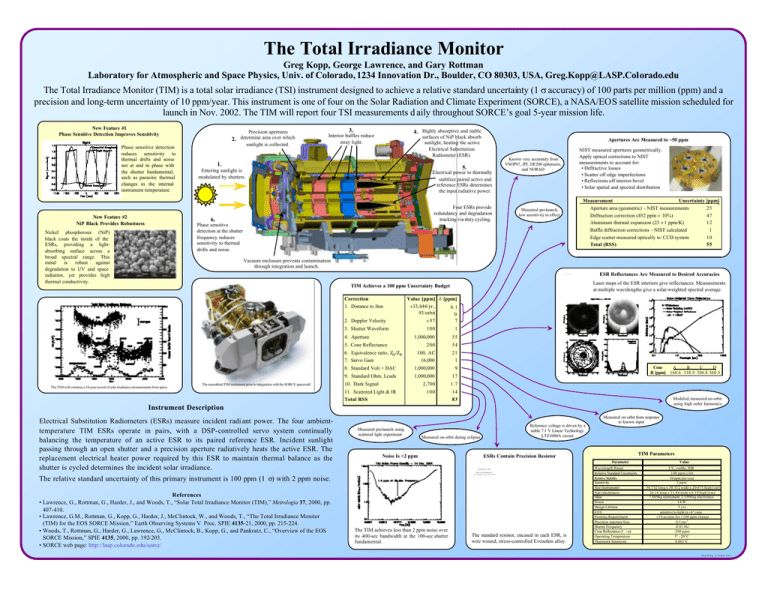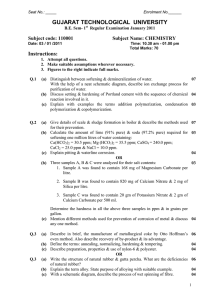The Total Irradiance Monitor
advertisement

The Total Irradiance Monitor Greg Kopp, George Lawrence, and Gary Rottman Laboratory for Atmospheric and Space Physics, Univ. of Colorado, 1234 Innovation Dr., Boulder, CO 80303, USA, Greg.Kopp@LASP.Colorado.edu The Total Irradiance Monitor (TIM) is a total solar irradiance (TSI) instrument designed to achieve a relative standard uncertainty (1 σ accuracy) of 100 parts per million (ppm) and a precision and long-term uncertainty of 10 ppm/year. This instrument is one of four on the Solar Radiation and Climate Experiment (SORCE), a NASA/EOS satellite mission scheduled for launch in Nov. 2002. The TIM will report four TSI measurements d aily throughout SORCE’s goal 5-year mission life. New Feature #1 Phase Sensitive Detection Improves Sensitivity Phase sensitive detection reduces sensitivity to thermal drifts and noise not at and in phase with the shutter fundamental, such as parasitic thermal changes in the internal instrument temperature. New Feature #2 NiP Black Provides Robustness Precision apertures 2. determine area over which sunlight is collected. 3. 4. Highly absorptive and stable Interior baffles reduce stray light. surfaces of NiP black absorb sunlight, heating the active Electrical Substitution Radiometer (ESR). 1. Apertures Are Measured to ~50 ppm 5. Entering sunlight is modulated by shutters. Electrical power to thermally stabilize paired active and reference ESRs determines the input radiative power. Four ESRs provide redundancy and degradation tracking via duty cycling. 6. NIST measured apertures geometrically. Apply optical corrections to NIST measurements to account for: • Diffractive losses • Scatter off edge imperfections • Reflections off interior bevel • Solar spatial and spectral distribution Known very accurately from VSOP87, JPL DE200 ephemeris, and NORAD Measurement Uncertainty [ppm] Aperture area (geometric) - NIST measurements 25 Diffraction correction (452 ppm ± 10%) 47 Aluminum thermal expansion (23 ± 1 ppm/K) 12 Baffle diffraction corrections - NIST calculated 1 Edge scatter measured optically w/ CCD system 10 Total (RSS) 55 Measured pre-launch; low sensitivity to effect Phase sensitive detection at the shutter frequency reduces sensitivity to thermal drifts and noise. Nickel phosphorous (NiP) black coats the inside of the ESRs, providing a lightabsorbing surface across a broad spectral range. This metal is robust against degradation to UV and space radiation, yet provides high thermal conductivity. Vacuum enclosure prevents contamination through integration and launch. a r e n e e d e d t o u s e t h i s p i c t u r e Correction 1. Distance to Sun 2. Doppler Velocity Value [ppm] δ [ppm] ±33,444/yr., 0.1 93/orbit 0. ±57 7 3. Shutter Waveform 4. Aperture 100 1 1,000,000 55 200 54 100, AC 16,000 21 1 5. Cone Reflectance 6. Equivalence ratio, ZH /ZR 7. Servo Gain The TIM will continue a 24-year record of solar irradiance measurements from space. The assembled TIM instrument prior to integration with the SORCE spacecraft. ESR Reflectances Are Measured to Desired Accuracies Laser maps of the ESR interiors give reflectances. Measurements at multiple wavelengths give a solar-weighted spectral average. TIM Achieves a 100 ppm Uncertainty Budget 8. Standard Volt + DAC 1,000,000 9 9. Standard Ohm, Leads 1,000,000 17 2,700 1.7 100 14 83 10. Dark Signal 11. Scattered Light & IR Total RSS Cone A B C D R [ppm] 168.6 138.9 306.8 360.5 Modeled; measured on-orbit using high order harmonics Instrument Description Electrical Substitution Radiometers (ESRs) measure incident radi ant power. The four ambienttemperature TIM ESRs operate in pairs, with a DSP-controlled servo system continually balancing the temperature of an active ESR to its paired reference ESR. Incident sunlight passing through an open shutter and a precision aperture radiatively heats the active ESR. The replacement electrical heater power required by this ESR to maintain thermal balance as the shutter is cycled determines the incident solar irradiance. The relative standard uncertainty of this primary instrument is 100 ppm (1 σ) with 2 ppm noise. References • Lawrence, G., Rottman, G., Harder, J., and Woods, T., “Solar Total Irradiance Monitor (TIM),” Metrologia 37, 2000, pp. 407-410. • Lawrence, G.M., Rottman, G., Kopp, G., Harder, J., McClintock, W., and Woods, T., “The Total Irradiance Monitor (TIM) for the EOS SORCE Mission,” Earth Observing Systems V Proc. SPIE 4135-21, 2000, pp. 215-224. • Woods, T., Rottman, G., Harder, G., Lawrence, G., McClintock, B., Kopp, G., and Pankratz, C., “Overview of the EOS SORCE Mission,” SPIE 4135, 2000, pp. 192-203. • SORCE web page: http://lasp.colorado.edu/sorce/ Measured pre-launch using scattered light experiment Reference voltage is driven by a stable 7.1 V Linear Technology LTZ1000A circuit Measured on-orbit during eclipses Noise Is <2 ppm Measured on-orbit from response to known input TIM Parameters ESRs Contain Precision Resistor Parameter QuickTime™ and a Photo CD Decompressor are needed to use this picture The TIM achieves less than 2 ppm noise over its 400-sec bandwidth at the 100-sec shutter fundamental. The standard resistor, encased in each ESR, is wire wound, stress-controlled Evenohm alloy. Wavelength Range Relative Standard Uncertainty Relative Stability Sensitivity Size (instrument) Size (electronics) Mass Power Design Lifetime FOV Pointing Requirement Precision Aperture Size Shutter Frequency Cone Reflectance (1 −α) Operating Temperature Thermistor Sensitivity Value UV, visible, NIR 100 ppm (1σ) 10 ppm per year 2 ppm 34.732 long x 30.312 wide x 20.671 high [cm] 26.16 long x 21.84 wide x 6.10 high [cm] 7.869 kg instrument, 2.3398 kg electronics 14 W 5 yrs sensitive to light in ±6° cone ±10 arcmin for ±100 ppm change 0.5 cm 2 0.01 Hz 200 ppm 5° - 20°C 0.001°C Greg Kopp, 12 August 2002



